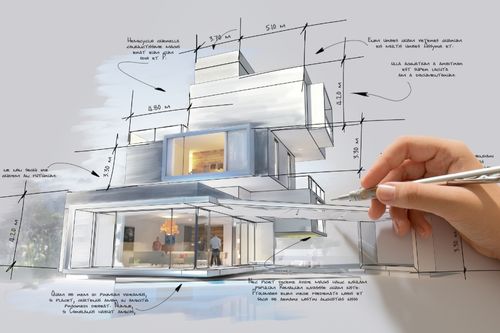Elevate Your Structure Layout with the Experience of CDA Architects
Elevate Your Structure Layout with the Experience of CDA Architects
Blog Article
An Extensive Summary of Building Designs and Their Impact on Modern City Planning and Growth
Architectural designs have actually long offered as a mirror to the societal values and technological developments of their time, playing a critical function in shaping contemporary city planning and growth. From the magnificence of Neoclassicism to the practical approach of Brutalism, each style has actually presented special concepts that influence metropolitan aesthetics and performance.
Historical Summary of Architectural Designs

As societies transitioned with the Middle Ages, Gothic style emerged, characterized by its verticality and intricate detailing, matching the spiritual goals of the era. The Renaissance noted a resurgence of timeless suitables, combining art and style in cutting-edge manner ins which affected subsequent designs throughout Europe.

Today, architectural styles remain to advance, driven by globalization and sustainability concerns, reflecting a dynamic interaction in between heritage and advancement. This historic introduction highlights the importance of style as a mirror of social advancement and as a stimulant for metropolitan advancement.
Trick Architectural Styles Explained
The variety of architectural designs mirrors the myriad influences that shape our developed environment, each personifying distinctive attributes and social values. Secret building designs include Classical, Gothic, Baroque, Modernism, and Postmodernism, each standing for distinct historic contexts and visual philosophies.
Timeless design, rooted in old Greece and Rome, stresses symmetry, proportion, and making use of columns (cda architects). On the other hand, Gothic architecture, flourishing between Ages, is identified by sharp arches, ribbed vaults, and flying buttresses, developing an angelic quality in sanctuaries. Baroque design, arising in the 17th century, is marked by grandeur, sophisticated embellishment, and a dynamic interaction of light and darkness
Innovation, which obtained momentum in the early 20th century, prioritizes feature over form, making use of brand-new materials like steel and glass to produce minimalist structures. Postmodernism, responding versus the austerity of Modernism, accepts eclecticism and historic referral, typically integrating spirited components and irony.

Effect On Urban Planning
In shaping the growth from this source of cities, building designs considerably affect metropolitan preparation choices. The selection of architectural design often determines the appearances, capability, and overall personality of urban atmospheres.
Additionally, building designs can impact zoning regulations and land utilize plans. Urban coordinators have to think about the prevailing architectural trends when making areas, making certain that new growths balance with existing frameworks. This factor to consider fosters natural urban landscapes and improves area identification.
The application of certain architectural styles can also affect socioeconomic factors within a city. Premium contemporary layouts might bring in upscale locals and services, leading to gentrification, while much more cost effective housing options could prioritize sensible and lasting layouts to accommodate varied populations. cda architects. Eventually, the interplay between architectural styles and city preparation creates vibrant cities that mirror both historical context and modern demands, forming the lived experiences of their residents
Sustainability and Modern Architecture
Building styles play a critical function in resolving modern challenges, particularly read this in the realm of sustainability. As urban locations increase and environmental concerns increase, contemporary style progressively accepts lasting layout concepts that prioritize power efficiency, resource preservation, and minimal environmental effect.
Contemporary architectural activities, such as biophilic layout and environment-friendly design, supporter for structures that harmonize with their surroundings, utilizing all-natural products and promoting biodiversity. These styles frequently include renewable energy resources, such as photovoltaic panels and wind turbines, to minimize dependence on fossil gas and lower carbon impacts.
In addition, the combination of advanced innovations, such as clever structure systems, enhances power monitoring, enhancing resource use while ensuring owner comfort. Innovative water monitoring techniques, including rain harvesting and greywater recycling, more contribute to sustainable city settings.
Significantly, sustainability extends beyond environmental problems; it encompasses social and financial measurements also. By cultivating community health and promoting inclusivity, modern architectural styles straighten with lasting development goals. Subsequently, the evolution of building techniques remains to shape resistant cities that not only fulfill the needs of the existing yet likewise guard the future for generations to come.
Area Involvement in Design
Area engagement in style acts as an essential bridge between architects and the populaces they offer, ensuring that the developed setting shows the needs and ambitions of its individuals. This collective procedure welcomes community participants to add their insights and choices, fostering a sense of possession and obligation towards the areas they populate.
Effective neighborhood engagement uses numerous approaches, such as workshops, surveys, and public forums, to gather diverse viewpoints. These techniques assist in a two-way dialogue, permitting designers to comprehend local contexts while empowering locals to articulate their issues and needs. This inclusivity not just enhances the layout high quality yet likewise promotes social equity by addressing the one-of-a-kind obstacles dealt with by marginalized teams.
In addition, area involvement can result in ingenious services that could not emerge in a standard design process. By integrating regional expertise and social values, designers can create rooms that resonate more deeply with users, boosting functionality and sustainability. Eventually, focusing on community involvement in design procedures leads to environments that nurture social interactions, support wellness, and enhance community connections, consequently playing an essential role fit modern-day city landscapes.
Final Thought
Architectural designs more information have actually profoundly affected modern city planning and development, reflecting evolving cultural and technical contexts. As cities continue to expand and adapt, the ongoing discussion between architectural heritage and contemporary design concepts will stay essential in producing inclusive, lively rooms that improve top quality of life and promote social equity.
Report this page